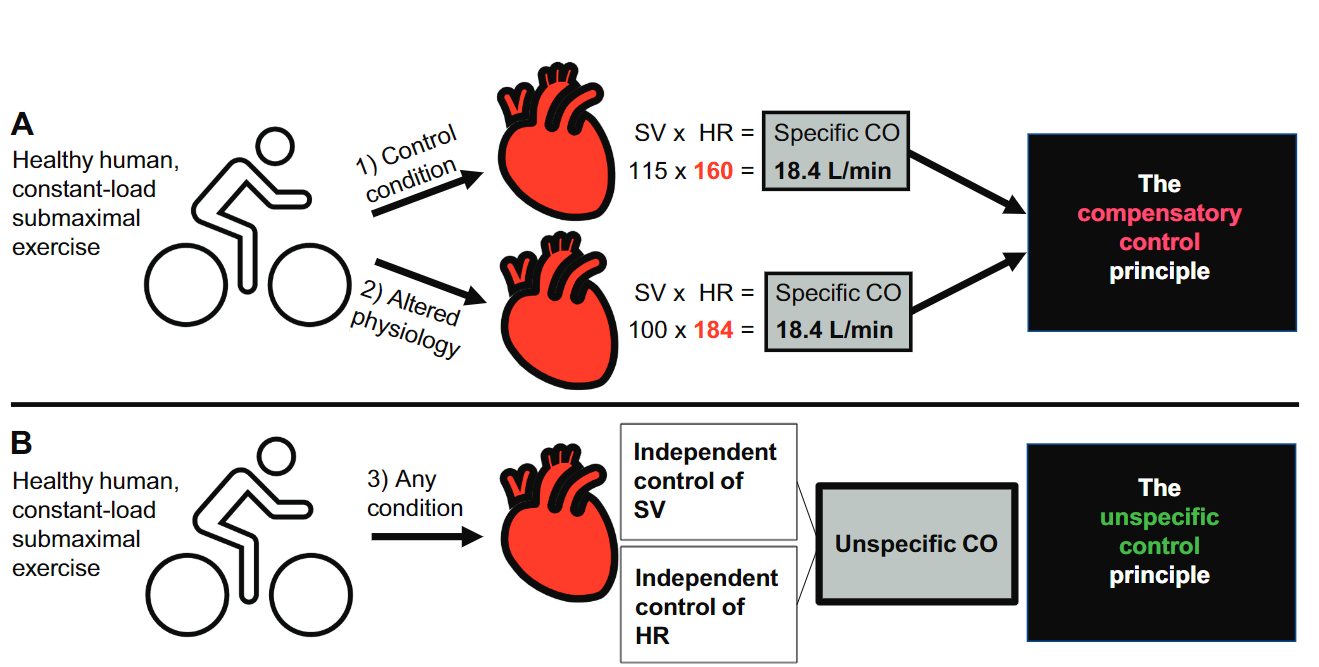
Physiology News Magazine
Your Heart May Not “Know”…
News and Views
Your Heart May Not “Know”…
News and Views

Professor Eric J. Stöhr
COR-HELIX (CardiOvascular Regulation and Human Exercise Laboratory – Integration and Xploration),
University of Hannover,Germany
I have been told many times that cardiac output increases during exercise proportionately to the workload. Most readers of this short article, I assume, have probably also heard or read similar statements. Such statements reflect the fundamental principle in human physiology that any increase in physical work and energetic demand must be matched by a greater oxygen consumption. The Fick principle beautifully highlights that this greater oxygen consumption can be achieved in two ways: by enhanced convective delivery of blood flow (i.e. cardiac output) and/ or by increased diffusive delivery of blood flow (i.e. local extraction of oxygen from the blood). Importantly, the heart itself has two components to control its overall output. The portion that can be termed the mechanical part, which is reflected by stroke volume (SV), and the component that can be referred to as being autonomic, which can be measured as heart rate (HR).
Like any healthy relationship, these two should talk to each other to agree on the joint outcome because a lower SV should be accompanied by a higher HR and vice versa, to result in the same cardiac output for a specific energetic demand. Only… SV and HR often seem to behave more like the cranky couple in your favourite Netflix drama – they do not seem to communicate well at all. To verify this scientifically, SV and HR need to be investigated during submaximal conditions when there is enough of a reserve for either contributor to make up for the shortcomings in the other. And indeed, several studies suggest that SV and HR do not adjust according to each other and do not produce a specific cardiac output (Stöhr, 2022). One such study, carried out by a talented Masters student during an Erasmus exchange programme, shall be briefly described here (van Mil et al., 2016):
Think of yourself as lying down on a comfortable bed in a laboratory. Then, your arms will be wrapped in a water-perfused suit and heated up. As expected, the blood flow in your arms will increase, but elsewhere in your body blood flow will remain normal. The increased blood flow in your arms will be matched by an increased HR while SV remains the same as before heating, reflecting the “hyperadrenergic state” referred to by Lowring Rowell (Rowell, 1990). Now comes the trick with which the heart will be challenged to make a crucial decision. Around your upper arms, blood pressure cuffs will be inflated to mean arterial pressure, reducing the blood flow in the arms back to the normal baseline condition. But they are still hot and HR is still up accordingly! Will the heart now produce the cardiac output for the hot condition (as it should), or will it not? The answer is, it will not, because SV will reduce during arm cuffing. These data suggest that the heart does not control its output according to the demand. Future studies should replicate this work under locally increased metabolic demand.
Although the results from the example may be surprising and perhaps even disconcerting, such observations give rise to exciting speculation. For example, it is possible that all the different components of the cardiovascular system are controlled separately, and that there is less “coupling” across the entire system than previously assumed. Or, there may be an as of yet undiscovered principle that explains the function of the heart and arteries in a new way, which does not rely on the assumption that the function of the heart is to provide the specific output according to the prevailing (energetic) demand. If this is true and the heart does not know how much blood flow our body needs, then the field will be wide open for radical new concepts in cardiovascular physiology.

References
Rowell LB (1990). Hyperthermia: a hyperadrenergic state. Hypertension 15, 505-507. doi. org//10.1161/01.HYP.15.5.505
Stöhr EJ (2022). The healthy heart does not control a specific cardiac output: a plea for a new interpretation of normal cardiac function. American Journal of Physiology-Heart and Circulatory Physiology 323, H1239-H1243. doi.org/10.1152/ ajpheart.00535.2022
van Mil AC et al. (2016). Interaction between left ventricular twist mechanics and arterial haemodynamics during localised, non-metabolic hyperaemia with and without blood flow restriction. Experimental Physiology 101, 509-520. doi.org/10.1113/EP085623
